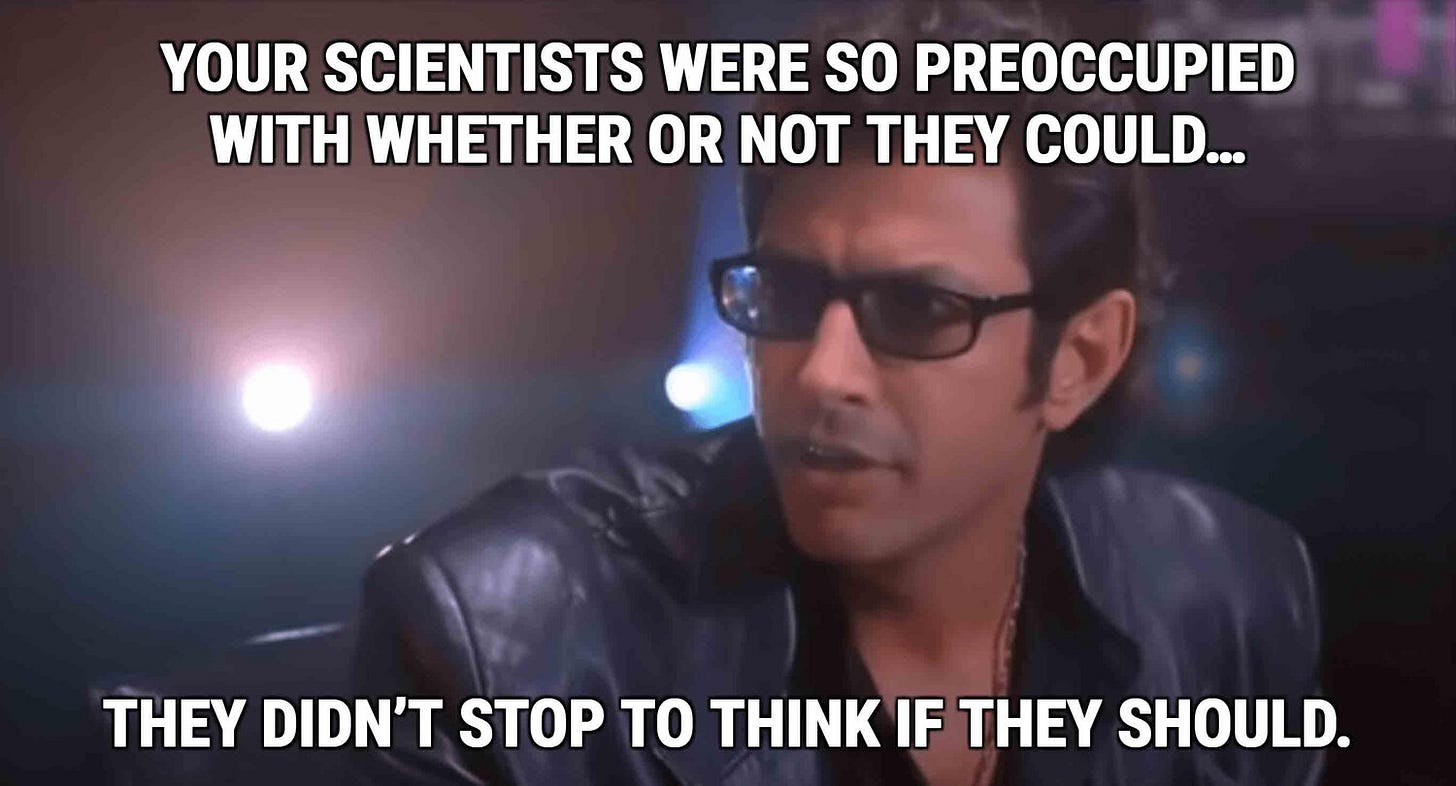Technology is not "inevitable"
Believing otherwise isn't merely wrong. It's dangerous.
I was reading The New York Times last Sunday when, to use an antiquated metaphor, the needle on my brain’s turntable screeched across the record and the music stopped.
The dissonance came mid-way through a lengthy profile of Sam Altman, the CEO of Open AI, the company that created ChatGPT — and the current furore over AI.
To spend time with Mr. Altman is to understand that Silicon Valley will push this technology forward even though it is not quite sure what the implications will be. At one point during our dinner in 2019, he paraphrased J. Robert Oppenheimer, the leader of the Manhattan Project, who believed the atomic bomb was an inevitability of scientific progress. “Technology happens because it is possible,” he said. (Mr. Altman pointed out that, as fate would have it, he and Oppenheimer share a birthday.)
With all due respect to fate, Oppenheimer, and Altman, this is wrong. It’s wrong in the specific case of the Manhattan Project. It’s wrong about technology in general.
But being wrong is the least of it. The idea that technology is “inevitable” is downright dangerous.
Lots of Silicon Valley types — both critics who want to slow things down and “accelerationists” who want to floor it — bring up the Manhattan Project in the context of the AI debate. That’s understandable.
The one thing that both sides of the AI debate seem to agree on is that AI could become a technology of such huge importance that it would effectively divide history into pre- and post-. As the printing press did. And the atom bomb did. Both sides, I think, also agree that AI is similar to the atom bomb in that it could be used to wonderful ends (drop a bomb on Hitler) or it could threaten the very existence of civilization (Hitler dropping bombs).
Given that the Manhattan Project keeps popping up in these discussions, one would think the Silicon Valley types have all read the history with great care. Comments like Altman’s suggest not.
There is abundant evidence that the development of the atom bomb was not remotely “inevitable.”
This essay by historian Alex Wellerstein, who specializes in the period, is an excellent summary.
The development of nuclear weapons during World War II is, in many ways, an unexpected and improbable outcome, and instead of asking why other nations did not develop such weapons, it is more fruitful to look instead at the various contingent and at times even coincidental factors that led to the United States being the only nation to pursue such a program with vigor.
Why was it “unexpected and improbable”? Because at the start of the war, there were massive uncertainties about whether it was even technically possible. And even if you agreed it could be done, the resources such an undertaking would require would be absolutely massive.
Here is Wellerstein’s summary of what the Manhattan Project ultimately required (emphasis mine):
It is difficult to overemphasize the scale of the work…. At its peak, it employed over 125,000 direct staff members, and probably a larger number of additional people were involved through the subcontracted labor that fed raw resources into the project. Because of the high rate of labor turnover on the project, some 500,000 Americans worked on some aspect of the sprawling Manhattan Project, almost 1% of the entire US civilian labor force during World War II. In 1943, the project was estimated to be consuming approximately over half of all Army construction labor and steel production, and the Oak Ridge site alone used approximately 1% of the electrical power produced for the entire country…. the total project sites across the United States number into the hundreds, including work done at over two dozen universities. It was not merely a scientific research project: it entailed the creation of an entirely new industry as well as the military coordination required to mobilize its byproducts as usable weapons, all under an unusually heavy cloak of military and governmental secrecy.
This map gives some sense of the scale of the Manhattan Project, although it actually understates the reality by leaving off the crucial contributions made by Britain.
And remember, this massive outpouring of resources was made in the context of a desperate global war, when resources were stretched to the limit and every country knew that a mistake in allocating resources could lose the war. Imagine how many more planes, ships, and tanks the United States could have produced if it hadn’t launched the Manhattan Project. Imagine all the other weapons it could have researched and developed with a much higher probability of success.
When Nazi Germany considered the problem, it concluded that it was technically possible to create an atom bomb but the cost was too great and the probability of success too low. The United Kingdom also explored the problem — and it turned what it learned over to the Americans because British officials believed they did not have the huge economic and natural resources required to pull it off.
The United States had by far the largest economy, along with an abundance of natural resources. Yet historians who have looked carefully at the American decision-making process have emphasized how easily the American decision could have gone the other way. In fact, when you consider traditional American grand strategy in war — build up massive numbers then start marching — it’s downright perplexing that the United States decided to green light the Manhattan Project.
For a fascinating look at the decision, watch this lecture (between 3:30 and 28:35) by historian Philip Zelikow (who is best known as the executive director of the 9/11 Commission.)
Still, you may say, if the US had not developed the atom bomb during the Second World War, it would have later. Eventually. Or someone else would have. Because the bomb was “inevitable.”
But note Zelikow’s argument on this point. A world war is a compelling argument for expending vast resources to develop a bomb that may or may not work. Absent that incentive, why would the United States have launched such a massive project? And if not the US, who? Other countries didn’t have America’s wealth, then or later. Without knowing whether it was even possible, any other country would have been mad to try.
Of course, we can imagine that in this alternate history the absence of nuclear weapons allowed conflict to escalate into a Third World War, thus providing, once again, strong incentive to invent the bomb. And this time, just the right set of circumstances for the launching of an atomic weapons program — timing, resources, personnel, key decision-makers — may have arisen at just the right time. But that takes us way down a road strewn with “maybes.”
And there are no maybes when something is “inevitable.”
I can understand the appeal of thinking things are inevitable. People loathe uncertainty. Inevitable is the opposite.
It’s particularly alluring if you are, say, a scientist developing a powerful technology that could deliver wonders to humanity, or hell on earth, or some unknowable mix of blessing and curse. You are confronted by a profound moral dilemma: “Should I do this? At what point does the risk of harm outweigh the possibility of benefit? Should I listen to Jeff Goldblum?” But if the technology is “inevitable” — poof! — the dilemma vanishes.
If the technology is inevitable, all that’s left to be decided is who will develop the technology, when it will be developed, and where.
Who should develop this technology? An unusually thoughtful and humane person like the scientist who is pondering this question and thinking highly of himself? The sort of person who will attempt to guide the technology toward positive uses as best he can? Or should the technology be developed by others, who are likely to be much less noble-minded? The question answers itself.
Now, as it happens, I think the atom bomb is a terrible analogy for AI. And Sam Altman is clearly not in the same position as Oppenheimer and Company: He can reasonably say that if he doesn’t do the work, others will. Because they are.
I just really hate talk of “inevitability.”
It invites moral laziness. And passivity. It encourages us to think of technology as being deterministic — that whatever is “possible” will be. Technology is irresistible. Humanity can only watch and hope for the best as technology works its will.
This fatalism is belied by the whole history of technology.
You know what determines whether technology happens or not, what form it takes, how it evolves? People do.
We decide. It’s that simple. We can exercise that power wisely or foolishly, individually or collectively. We can even choose to do nothing. But no matter what we do or don’t do, our choices shape the technology and can even determine whether the technology comes into existence at all.
Because technology is not inevitable.






Agree Dan that people decide. The over arching issue is prisoners dilemma
It seems like technology is only inevitable when economics and innovation align. So far supersonic flight, cryptocurrency, and drone delivery have all been created but never widely adopted. Flying cars also technically possible but far from feasible.